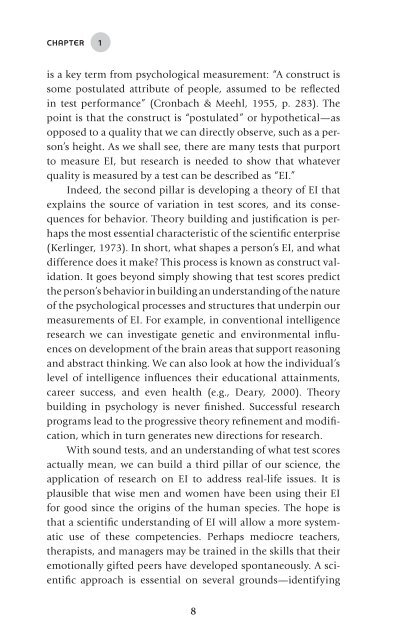Untitled - Springer Publishing
Untitled - Springer Publishing
Untitled - Springer Publishing
You also want an ePaper? Increase the reach of your titles
YUMPU automatically turns print PDFs into web optimized ePapers that Google loves.
CHAPTER 1<br />
is a key term from psychological measurement: “A construct is<br />
some postulated attribute of people, assumed to be reflected<br />
in test performance” (Cronbach & Meehl, 1955, p. 283). The<br />
point is that the construct is “postulated” or hypothetical—as<br />
opposed to a quality that we can directly observe, such as a person’s<br />
height. As we shall see, there are many tests that purport<br />
to measure EI, but research is needed to show that whatever<br />
quality is measured by a test can be described as “EI.”<br />
Indeed, the second pillar is developing a theory of EI that<br />
explains the source of variation in test scores, and its consequences<br />
for behavior. Theory building and justification is perhaps<br />
the most essential characteristic of the scientific enterprise<br />
(Kerlinger, 1973). In short, what shapes a person’s EI, and what<br />
difference does it make? This process is known as construct validation.<br />
It goes beyond simply showing that test scores predict<br />
the person’s behavior in building an understanding of the nature<br />
of the psychological processes and structures that underpin our<br />
measurements of EI. For example, in conventional intelligence<br />
research we can investigate genetic and environmental influences<br />
on development of the brain areas that support reasoning<br />
and abstract thinking. We can also look at how the individual’s<br />
level of intelligence influences their educational attainments,<br />
career success, and even health (e.g., Deary, 2000). Theory<br />
building in psychology is never finished. Successful research<br />
programs lead to the progressive theory refinement and modification,<br />
which in turn generates new directions for research.<br />
With sound tests, and an understanding of what test scores<br />
actually mean, we can build a third pillar of our science, the<br />
application of research on EI to address real-life issues. It is<br />
plausible that wise men and women have been using their EI<br />
for good since the origins of the human species. The hope is<br />
that a scientific understanding of EI will allow a more systematic<br />
use of these competencies. Perhaps mediocre teachers,<br />
therapists, and managers may be trained in the skills that their<br />
emotionally gifted peers have developed spontaneously. A scientific<br />
approach is essential on several grounds—identifying<br />
8<br />
Matthews_PTR_Ch 01_12-10-11_1-42.indd 8<br />
10/12/2011 10:46:53 AM
















